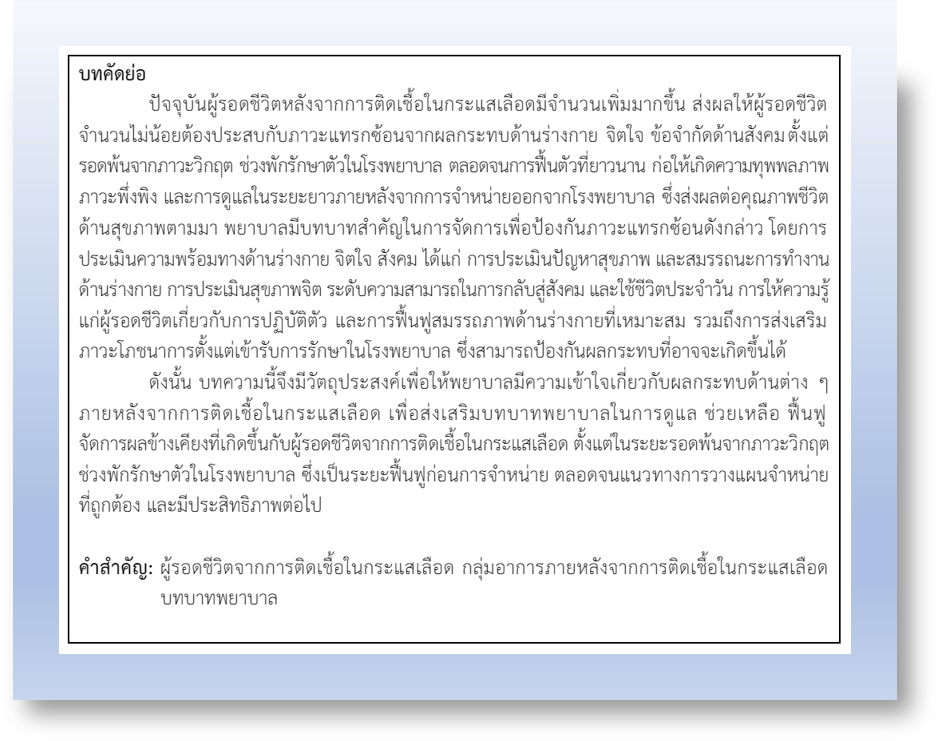บทบาทพยาบาลกับการจัดการผู้รอดชีวิตภายหลังจากการติดเชื้อในกระแสเลือด
คำสำคัญ:
ผู้รอดชีวิตจากการติดเชื้อในกระแสเลือด, กลุ่มอาการภายหลังจากการติดเชื้อในกระแสเลือด, บทบาทพยาบาลบทคัดย่อ
ปัจจุบันผู้รอดชีวิตหลังจากการติดเชื้อในกระแสเลือดมีจำนวนเพิ่มมากขึ้น ส่งผลให้ผู้รอดชีวิตจำนวนไม่น้อยต้องประสบกับภาวะแทรกซ้อนจากผลกระทบด้านร่างกาย จิตใจ ข้อจำกัดด้านสังคมตั้งแต่รอดพ้นจากภาวะวิกฤต ช่วงพักรักษาตัวในโรงพยาบาล ตลอดจนการฟื้นตัวที่ยาวนาน ก่อให้เกิดความทุพพลภาพ ภาวะพึ่งพิง และการดูแลในระยะยาวภายหลังจากการจำหน่ายออกจากโรงพยาบาล ซึ่งส่งผลต่อคุณภาพชีวิตด้านสุขภาพตามมา พยาบาลมีบทบาทสำคัญในการจัดการเพื่อป้องกันภาวะแทรกซ้อนดังกล่าว โดยการประเมินความพร้อมทางด้านร่างกาย จิตใจ สังคม ได้แก่ การประเมินปัญหาสุขภาพ และสมรรถนะการทำงานด้านร่างกาย การประเมินสุขภาพจิต ระดับความสามารถในการกลับสู่สังคม และใช้ชีวิตประจำวัน การให้ความรู้แก่ผู้รอดชีวิตเกี่ยวกับการปฏิบัติตัว และการฟื้นฟูสมรรถภาพด้านร่างกายที่เหมาะสม รวมถึงการส่งเสริมภาวะโภชนาการตั้งแต่เข้ารับการรักษาในโรงพยาบาล ซึ่งสามารถป้องกันผลกระทบที่อาจจะเกิดขึ้นได้
ดังนั้น บทความนี้จึงมีวัตถุประสงค์เพื่อให้พยาบาลมีความเข้าใจเกี่ยวกับผลกระทบด้านต่าง ๆ ภายหลังจากการติดเชื้อในกระแสเลือด เพื่อส่งเสริมบทบาทพยาบาลในการดูแล ช่วยเหลือ ฟื้นฟู จัดการผลข้างเคียงที่เกิดขึ้นกับผู้รอดชีวิตจากการติดเชื้อในกระแสเลือด ตั้งแต่ในระยะรอดพ้นจากภาวะวิกฤต ช่วงพักรักษาตัวในโรงพยาบาล ซึ่งเป็นระยะฟื้นฟูก่อนการจำหน่าย ตลอดจนแนวทางการวางแผนจำหน่ายที่ถูกต้อง และมีประสิทธิภาพต่อไป
เอกสารอ้างอิง
Levy MM, Evans LE, Rhodes A. The surviving sepsis campaign bundle: 2018 update. Intensive Care Medicine 2018;44(6):925-8. doi: 10.1007/s00134-018-5085-0.
Taj M, Brenner M, Sulaiman Z, Pandian V. Sepsis protocols to reduce mortality in resource-restricted settings: a systematic review. Intensive and Critical Care Nursing 2022;72:103255. doi: 10.1016/j.iccn.2022.103255.
Strategy and Planning Division of Office of the Permanent Secretary Ministry of Public Health. Public health statistics A.D. 2019 [Internet]. 2019 [cited 2023 Jul 15]. Available from: http://www.pcko.moph.go.th/Health-Statistics/statistic2562.pdf (in Thai)
Prescott HC, Angus DC. Enhancing recovery from sepsis: a review. Journal of the American Medical Association 2018;319(1):62-75. doi: 10.1001/jama.2017.17687.
Annane D, Sharshar T. Cognitive decline after sepsis. The Lancet. Respiratory Medicine 2015;3(1):61-9. doi: 10.1016/S2213-2600(14)70246-2.
Mostel Z, Perl A, Marck M, Mehdi SF, Lowell B, Bathija S, et al. Post-sepsis syndrome - an evolving entity that afflicts survivors of sepsis. Molecular Medicine 2019;26(1):6. doi: 10.1186/s10020-019-0132-z.
Thompson K, Taylor C, Jan S, Li Q, Hammond N, Myburgh J, et al. Health-related outcomes of critically ill patients with and without sepsis. Intensive Care Medicine 2018;44(8):1249-57. doi: 10.1007/s00134-018-5274-x.
Plevin R, Callcut R. Update in sepsis guidelines: what is really new?. Trauma Surgery and Acute Care Open 2017;2(1):e000088. doi: 10.1136/tsaco-2017-000088.
Makic MBF, Bridges E. CE: managing sepsis and septic shock: current guidelines and definitions. American Journal of Nursing 2018;118(2):34-9. doi: 10.1097/01.NAJ.0000530223.33211.f5.
van der Slikke EC, An AY, Hancock REW, Bouma HR. Exploring the pathophysiology of post-sepsis syndrome to identify therapeutic opportunities. EBioMedicine 2020;61:103044. doi: 10.1016/j.ebiom.2020.103044.
Apitzsch S, Larsson L, Larsson AK, Linder A. The physical and mental impact of surviving sepsis - a qualitative study of experiences and perceptions among a Swedish sample. Archives of Public Health 2021;79(1):66. doi: 10.1186/s13690-021-00585-5.
Rahmel T, Schmitz S, Nowak H, Schepanek K, Bergmann L, Halberstadt P, et al. Long-term mortality and outcome in hospital survivors of septic shock, sepsis, and severe infections: the importance of aftercare. PLoS ONE 2020;15(2):e0228952. doi: 10.1371/journal.pone.0228952.
Venet F, Monneret G. Advances in the understanding and treatment of sepsis-induced immunosuppression. Nature Reviews. Nephrology 2018;14(2):121-37. doi: 10.1038/nrneph.2017.165.
Prescott HC, Langa KM, Iwashyna TJ. Readmission diagnoses after hospitalization for severe sepsis and other acute medical conditions. Journal of the American Medical Association 2015;313(10):1055-7. doi: 10.1001/jama.2015.1410.
Zielske J, Bohne S, Brunkhorst FM, Axer H, Guntinas-Lichius O. Acute and long-term dysphagia in critically ill patients with severe sepsis: results of a prospective controlled observational study. European Archives of Oto-Rhino-Laryngology 2014;271(11):3085-93. doi: 10.1007/s00405-014-3148-6.
Yende S, Linde-Zwirble W, Mayr F, Weissfeld LA, Reis S, Angus DC. Risk of cardiovascular events in survivors of severe sepsis. American Journal of Respiratory and Critical Care Medicine 2014;189(9):1065-74. doi: 10.1164/rccm.201307-1321OC.
Marik PE, Khangoora V, Rivera R, Hooper MH, Catravas J. Hydrocortisone, Vitamin C, and Thiamine for the treatment of severe sepsis and septic shock: a retrospective before-after study. Chest 2017;151(6):1229-38. doi: 10.1016/j.chest.2016.11.036.
Moore FA, Phillips SM, McClain CJ, Patel JJ, Martindale RG. Nutrition support for persistent inflammation, immunosuppression, and catabolism syndrome. Nutrition in Clinical Practice 2017;32 Suppl 1:S121-7. doi: 10.1177/0884533616687502.
Ahn JY, Song JE, Ann HW, Jeon Y, Ahn MY, Jung IY, et al. Effects of early exercise rehabilitation on functional recovery in patients with severe sepsis. Yonsei Medical Journal 2018;59(7):843-51. doi: 10.3349/ymj.2018.59.7.843.
Prescott HC, Langa KM, Liu V, Escobar GJ, Iwashyna TJ. Increased 1-year healthcare use in survivors of severe sepsis. American Journal of Respiratory and Critical care Medicine 2014;190(1):62-9. doi: 10.1164/rccm.201403-0471OC.
Davydow DS, Hough CL, Langa KM, Iwashyna TJ. Depressive symptoms in spouses of older patients with severe sepsis. Critical Care Medicine 2012;40(8):2335-41. doi: 10.1097/CCM.0b013e3182536a81.
Borges RC, Carvalho CRF, Colombo AS, da Silva Borges MP, Soriano FG. Physical activity, muscle strength, and exercise capacity 3 months after severe sepsis and septic shock. Intensive Care Medicine 2015;41(8):1433-44. doi: 10.1007/s00134-015-3914-y.
Wintermann GB, Rosendahl J, Weidner K, Strauss B, Hinz A, Petrowski K. Fatigue in chronically critically ill patients following intensive care - reliability and validity of the multidimensional fatigue inventory (MFI-20). Health and Quality of Life Outcomes 2018;16(1):37. doi: 10.1186/s12955-018-0862-6.
Panumgul L, Puwarawuttipanit W, Poungkaew A, Rongrungruang Y. Factors predicting sepsis in the medical patients. Nursing Science Journal of Thailand 2021;39(3):74-90. (in Thai)
Calsavara AJ, Costa PA, Nobre V, Teixeira AL. Prevalence and risk factors for post-traumatic stress, anxiety, and depression in sepsis survivors after ICU discharge. Revista Brasileira de Psiquiatria 2021;43(3):269-76. doi: 10.1590/1516-4446-2020-0986.
Kowalkowski M, Chou SH, McWilliams A, Lashley C, Murphy S, Rossman W, et al. Structured, proactive care coordination versus usual care for Improving Morbidity during Post-Acute Care Transitions for Sepsis (IMPACTS): a pragmatic, randomized controlled trial. Trials 2019;20(1):660. doi: 10.1186/s13063-019-3792-7.
Taylor SP, Murphy S, Rios A, McWilliams A, McCurdy L, Chou SH, et al. Effect of a multicomponent sepsis transition and recovery program on mortality and readmissions after sepsis: the improving morbidity during post-acute care transitions for sepsis randomized clinical trial. Critical Care Medicine 2022;50(3):469-79. doi: 10.1097/CCM.0000000000005300.

ดาวน์โหลด
เผยแพร่แล้ว
รูปแบบการอ้างอิง
ฉบับ
ประเภทบทความ
สัญญาอนุญาต
ลิขสิทธิ์ (c) 2024 วารสารเกื้อการุณย์

อนุญาตภายใต้เงื่อนไข Creative Commons Attribution-NonCommercial-NoDerivatives 4.0 International License.














